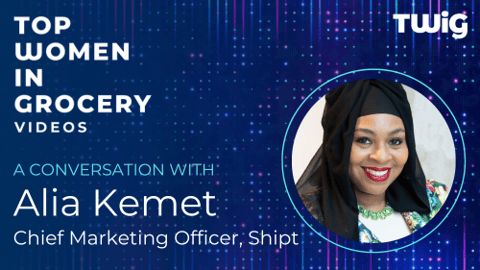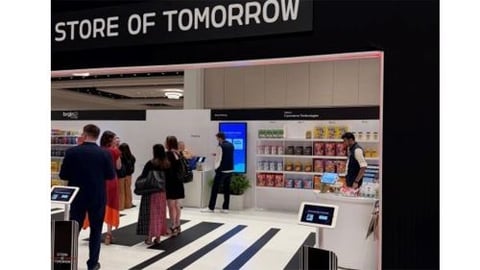EXCLUSIVE: How Amazon is Focusing on the Easy Button for Grocery
In the collective quest to make things easier for consumers, has grocery shopping actually become more complicated? A case for that can be made, according to Anand Varadarajan, VP, product technology, worldwide grocery stores, for Amazon, who spoke at a recent “Delivering the Future” event in Nashville.
In his presentation, he underscored the cacophony of the current marketplace. “Shopping for food and household goods is something we do regularly throughout the week, and yet instead of it getting easier, it's gotten more complicated. Think about it. There are more products than ever competing for a place in your shopping cart and more brands and more price points to consider,” he pointed out. “And while this added choice is a benefit, it comes at a cost. People now must use more time and brainpower to get what they need at the right price. In fact, the average consumer visits between four and five different retailers for groceries every month.”
Citing this environment, Varadarajan and other Amazon officials shared details of new technologies aimed at cutting through the proverbial clutter to deliver a seamless experience. Among other updates, Amazon is now piloting the delivery of groceries and other everyday popular items bundled together through same-day and overnight delivery and expects to expand that service to other locations. Additionally, the company announced that it is building its first-ever micro-fulfillment center located in a Whole Foods Market store in Plymouth Meeting, Pa.; that site should come online in early 2025. Nine Amazon Fresh fulfillment centers have also been updated to allow shoppers to order more products from Whole Foods and Amazon.com, and four other fulfillment center enhancements are planned.
Progressive Grocer caught up with Varadarajan after his presentation at the “Delivering the Future” event to get more details on how the company’s history of innovation is disruptive but not, in the end, complicated for shoppers.
Progressive Grocer: I want to start with by observing that you seem so enthusiastic about the grocery sector when you speak. What do you like about being in this space?
Anand Varadarajan: It focuses around for our customers and I think that's what makes it so special for me – being part of a team at Amazon where, at the scale at which we operate, if we can make a difference in our customer's life and it comes to grocery, I think it'll be very meaningful. And that's what gets me excited every single day.
PG: Right – this side of the business makes a difference every day, because of the nature of buying foods and household essentials.
AV: I mean that's what makes it so important. It's not just a big industry, but it's an important part of our customers’ lives. And if we can make it easier, fast and affordable, I think I can look back and say I had an impact.
PG: Amazon is known for scrappiness as a company. How does that work in a mature industry like grocery? Are you still able to be scrappy and be out there making all these innovations yet still resonate with shoppers who are comfortable with the familiar?
AV: Absolutely. I think we want to meet our customers’ needs better where they are, be it online, be it in store. We already have a large established business online. And in addition to that, we have Whole Foods Market, which has a large physical presence. I think we are using that experience to build our physical presence for Amazon Fresh and Amazon Go.
PG: How does the pilot test that enables same-day delivery of groceries and other Amazon orders reflect your intention to make experiences easier for shoppers?
AV: Our work there allows us to start building towards that vision where a customer who might want to buy socks or a tennis racket can also think about what they want next day from a grocery perspective. And if they add it to their order, they can get it in one delivery to their doorstep.
PG: How has the trust factor helped Amazon in the grocery segment, now that shoppers rely on your ability to deliver?
AV: It's a huge part, and that's part of the reason why we feel optimistic that we can make a difference. Hundreds of millions of customers already trust Amazon with their general merchandise needs. So, if we can provide the same convenience when it comes to fresh groceries and hold the high standards that they come to expect from us, either from a quality or a delivery perspective, we think we can make grocery shopping simpler, faster, and easier.
PG: Consumers do like discovery, like finding new products and brands. How do you balance discovery with using technology?
AV: I think to your point, it needs to be a balance. On one hand, we have data on how customers shop both online and in store. That allows us to make grocery shopping easier by recommending things, like, "Hey, here are your past purchases" or "Continue where you left off." But, on the other hand, as they shop, we use what they're already having in their basket or what they're looking for to further recommend potentially new products that they might be interested in. So, if they're shopping for, let's say pancakes, and there's a up-and-coming syrup brand, we can share that.
Rufus, our shopping assistant, is another way in which we can aid discovery for customers, where they can have a conversational interface and that might help them find new recipes or new ingredients that they might not have thought of before.
PG: Finally, we talk about complex experiences for shoppers. Are you taking the complications off the consumer and putting them on your end? Is Amazon taking on all that complication?
AV: Our goal is to make every single option as easy, as fast and as affordable as possible. If they do want to shop online, we want to give them access to all our selection. If they do want to shop in store, the micro-fulfillment center is an example, where we can give them an option to shop an expanded selection without having to do more than one stop. We do want to take the complication from our customers and internalize it so that we can make grocery shopping fast, easy and affordable.






